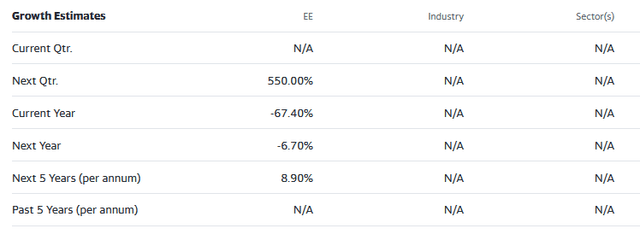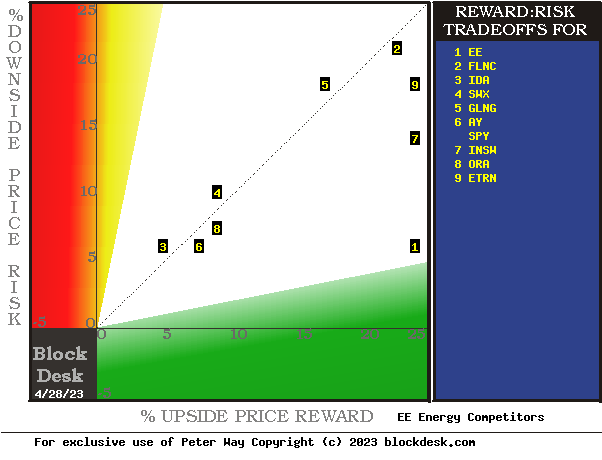The primary focus of this article is Excelerate Energy, Inc. (NYSE:EE).
Investment Thesis
21st Century paces of change in technology and rational behavior (not of emotional reactions) seriously disrupts the commonly accepted productive investment strategy of the 20th century.
One required change is the shortening of forecast horizons, with a shift from the multi-year passive approach of buy&hold to the active strategy of specific price-change target achievement or time-limit actions, with reinvestment set to new nearer-term targets.
That change avoids the irretrievable loss of invested time spent destructively by failure to recognize shifting evolutions like the cases of IBM, Kodak, GM, Xerox, GE and many earlier others.
It recognizes the progress in medical, communication and information technologies and enjoys their operational benefits already present in extended lifetimes, trade-commission-free investments, and coming benefits in transportation utilizations and energy usage.
But it requires the ability to make valid direct comparisons of value between investment reward prospects and risk exposures in the uncertain future. Since uncertainty expands as the future dimension increases, shorter forecast horizons are a means of improving the reward-to-risk comparison.
That shortening is now best attended at the investment entry point by knowing Market-Maker expectations for coming prices. When reached, their updates are then reintroduced at the exit/reinvestment point and the term of expectations for the required coming comparisons are recognized as the decision entry point to move forward.
We employ arbitrage science to determine the MM community’s near-term price expectations limits as a continuing measure of the balance between market-price prospective risk and reward. Then monitor subsequent actual market performance to identify opportunities.
For investments guided by this article or by others, target sell prices will always be found here as the high price in the MM forecast range.
Description of Equity Subject Company
“Excelerate Energy, Inc. provides flexible liquefied natural gas (LNG) solutions worldwide. The company offers regasification services, including floating storage and regasification units (FSRUs), infrastructure development, and LNG and natural gas supply, procurement, and distribution services; LNG terminal services; natural gas supply to-power projects; and a suite of smaller-scale gas distribution solutions. It also leases an LNG terminal in Bahia, Brazil. Excelerate Energy, Inc. was founded in 2003 and is headquartered in The Woodlands, Texas. Excelerate Energy, Inc. operates as a subsidiary of Excelerate Energy Holdings, LLC.”
Source: Yahoo Finance

Yahoo Finance
These growth estimates have been made by and are collected from Wall Street analysts to suggest what conventional methodology currently produces. The typical variations across forecast horizons of different time periods illustrate the difficulty of making value comparisons when the forecast horizon is not clearly defined.
Risk and Reward Balances Among Energy Developer Competitors
Figure 1

blockdesk.com
used with permission
The risk dimension is of actual price drawdowns at their most extreme point while being held in previous pursuit of upside rewards similar to the ones currently being seen. They are measured on the red vertical scale. Reward expectations are measured on the green horizontal scale.
Both scales are of percent change from zero to 25%. Any stock or ETF whose present risk exposure exceeds its reward prospect will be above the dotted diagonal line. Capital-gain-attractive to-buy issues are in the directions down and to the right.
Our principal interest is in EE at location [1], close to the upper edge of the green 5 to 1 reward~risk area. A “market index” norm of reward~risk tradeoffs is offered by SPY at [6], about the same vertical Risk scale as EE but with shrimp Reward prospect. Most appealing by this Figure 1 view for wealth-building investors must be EE.
Comparable features of Energy Provider Competitors
The Figure 1 map provides a good visual comparison of the two most important aspects of every equity investment in the short term. There are other aspects of comparison which this map sometimes does not communicate well, particularly when general market perspectives like those of SPY are involved. Where questions of “how likely’ are present other comparative tables, like Figure 2, may be useful.
Yellow highlighting of the table’s cells emphasize factors important to securities valuations and the security EE, most promising of near capital gain as ranked in column [R].
Figure 2

blockdesk.com
(used with permission)
Why do All This Math?
Figure 2’s purpose is to attempt universally comparable answers, stock by stock, of a) How BIG the prospective price gain payoff may be, b) how LIKELY the payoff will be a profitable experience, c) how SOON it may happen, and d) what price draw-down RISK may be encountered during its active holding period.
Readers familiar with our analysis methods after quick examination of Figure 2 may wish to skip to the next section viewing price range forecast trends for EE.
Column headers for Figure 2 define investment-choice preference elements for each row stock whose symbol appears at the left in column [A]. The elements are derived or calculated separately for each stock, based on the specifics of its situation and current-day MM price-range forecasts. Data in red numerals are negative, usually undesirable to “long” holding positions. Table cells with yellow fills are of data for the stocks of principal interest and of all issues at the ranking column, [R]. Pink fills suggest abnormal, undesirable statistics.
The price-range forecast limits of columns [B] and [C] get defined by MM hedging actions to protect firm capital required to be put at risk of price changes from volume trade orders placed by big-$ “institutional” clients.
[E] measures potential upside risks for MM short positions created to fill such orders, and reward potentials for the buy-side positions so created. Prior forecasts like the present provide a history of relevant price draw-down risks for buyers. The most severe ones actually encountered are in [F], during holding periods in effort to reach [E] gains. Those are where buyers are emotionally most likely to accept losses.
The Range Index [G] tells where today’s price lies relative to the MM community’s forecast of upper and lower limits of coming prices. Its numeric is the percentage proportion of the full low to high forecast seen below the current market price.
[H] tells what proportion of the [L] sample of prior like-balance forecasts have earned gains by either having price reach its [B] target or be above its [D] entry cost at the end of a 3-month max-patience holding period limit. [ I ] gives the net gains-losses of those [L] experiences.
What makes EE most attractive in the group at this point in time is its ability to produce capital gains most consistently at its present operating balance between share price risk and reward at the Range Index [G]. At a RI of 6, today’s price is near the bottom of its forecast range, with price expectations to the upside four times as much. Not our expectations, but those of Market-Makers acting in support of Institutional Investment organization clients building the values of their typical multi-billion-$ portfolios.
Further Reward~Risk tradeoffs involve using the [H] odds for gains with the 100 – H loss odds as weights for N-conditioned [E] and for [F], for a combined-return score [Q]. The typical position holding period [J] on [Q] provides a figure of merit [fom] ranking measure [R] useful in portfolio position preferencing. Figure 2 is row-ranked on [R] among alternative candidate securities, with EE in top rank.
Along with the candidate-specific stocks these selection considerations are provided for the averages of some 3,300 stocks for which MM price-range forecasts are available today, and 20 of the best-ranked (by fom) of those forecasts, as well as the forecast for S&P500 Index ETF (SPY) as an equity-market proxy.
Current-market index SPY is only moderately competitive as an investment alternative. Its Range Index of 31 indicates two-thirds of its forecast range is to the upside, while about three quarters of previous SPY forecasts at this range index produced profitable outcomes.
As shown in column [T] of figure 2, the levels vary significantly between stocks. What matters is the net gain between investment gains and losses actually achieved following the forecasts, shown in column [I]. The Win Odds of [H] tells what proportion of the Sample RIs of each stock were profitable. Odds below 80% often have proven to lack reliability. All of EE’s forecasts of RIs at 16 in the past 5 years have been profitable under our standard risk-management discipline.
Recent Forecast Trends of the Primary Subject
Figure 3

blockdesk.com
(used with permission)
Many investors confuse any time-repeating picture of stock prices with typical “technical analysis charts” of past stock price history. These are quite different in their content. Instead, here Figure 3’s vertical lines are a daily-updated visual record of price range forecast limits expected in the coming few weeks and months. The heavy dot in each vertical is the stock’s closing price on the day the forecast was made.
That market price point makes an explicit definition of the price reward and risk exposure, expectations which were held by market participants at the time. This is a visual display of their vertical balance between risk and reward.
The measure of that balance is the Range Index (RI).
With today’s RI of 16, EE has 16% upside price change in prospect. Of the prior 10 forecasts like today’s RI, all have been profitable. The market’s actions of prior forecasts became accomplishments of +10.3% gains in 42 market days., or 8+ weeks. So history’s advantage could be repeated six times or more in a 252 market-day year, which compounds into a CAGR of +81%.
Also please note the smaller low picture in Figure 3. It shows the past 5 year distribution of Range Indexes with the current level visually marked. For EE the most recent past forecasts have been of higher prices and Range Indexes.
Conclusion
Based on direct comparisons with EE and other Energy Provider competitors, there are strong wealth-building reasons to prefer a capital-gain seeking buy in Excelerate Energy Inc. over other examined alternatives.
Read the full article here




